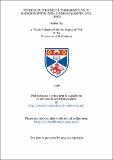Studies on chromatin conformation of radiosensitive (xrs) Chinese hamster cell lines
Abstract
The objective of this project was to investigate the chromatin structure of the mutant Chinese hamster ovary cell line, xrs, the project consisted of two parts by; a radiobiological study, and a protein chemistry study and to specifically ask, whether or not the increased susceptibility of the x family of mutants compared to wt could be attributed to modifications to structure of chromatin or are the modifications a pleiotropic effect of the mutated gene. The radiobiological study used the change in DNA radiosensitivity with progressive removal of DNA bound proteins as a probe to investigate the chromatin conformation of CHO KI and xrs. The DNA alkaline unwinding assay, showed that there was a difference in sensitivity to ionising radiation (IR)-induced damage between xrs-5 and CHO KI after treatment with various concentrations of salt (0.25-0.75 M NaCl) and y-rays (0.25-0.75 Gy), 0.75M NaCl and 0.75 Gy gave maximal effects. The sensitivity difference between mutant and wt was less obvious with NaCl treatment at 0.75 Gy y-irradiation but nonetheless apparent. This radiosensitivity could be attributed to structural modifications in the mutant cell lines. These structural modifications are represented graphically in two algebraic forms i.e. a quadratic (y=mx2) and a quartic sine (y= ax4 + bx3 + cx4 + dx+ C) in CHO KI and xrs-5 respectively. The decrease in unwinding in hypertonic solutions was thought to be attributable to either ongoing fast ssb repair, a faster unwinding population, or, loss of DNA supercoiling due to high salt and irradiation, or negative interaction between one unwound DNA population and a adjacent break points leading to saturation. Partial reversion of .xrs-5 did not alter the unwinding profile markedly. As deduced from the observation that despite the partial reversion the mutant was consistently more susceptible to IR-induced DNA damage compared to wt. The difference in DNA radiosensitivity in this assay of mutant compared to wt may not necessarily reflect the radiosensitivity of the xrs cells. The protein chemistry study showed that there was a difference observed between protein extracts of mutant xrs-6 and wt, with respect to histone-related proteins. Specifically, a species of 31 kDa was detectable in extracts of wt but not xrs-6 mutant cells. The possible identity of this polypeptide and the role of candidate proteins in chromatin structure and radiosensitivity is discussed.
Type
Thesis, PhD Doctor of Philosophy
Collections
Items in the St Andrews Research Repository are protected by copyright, with all rights reserved, unless otherwise indicated.

